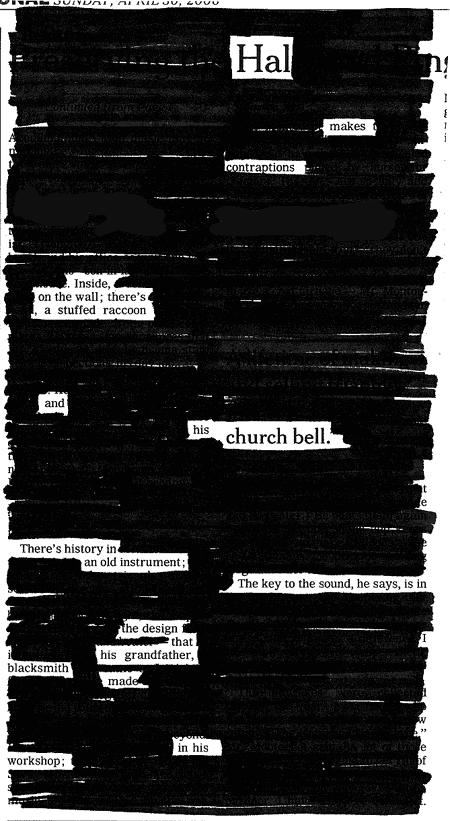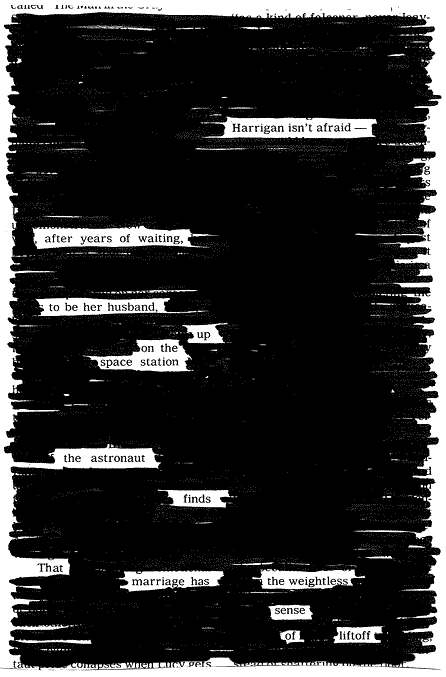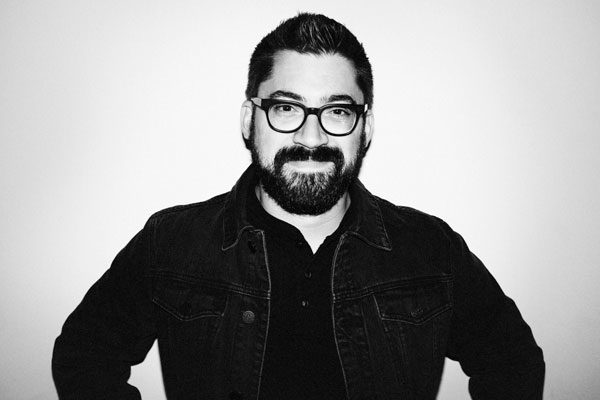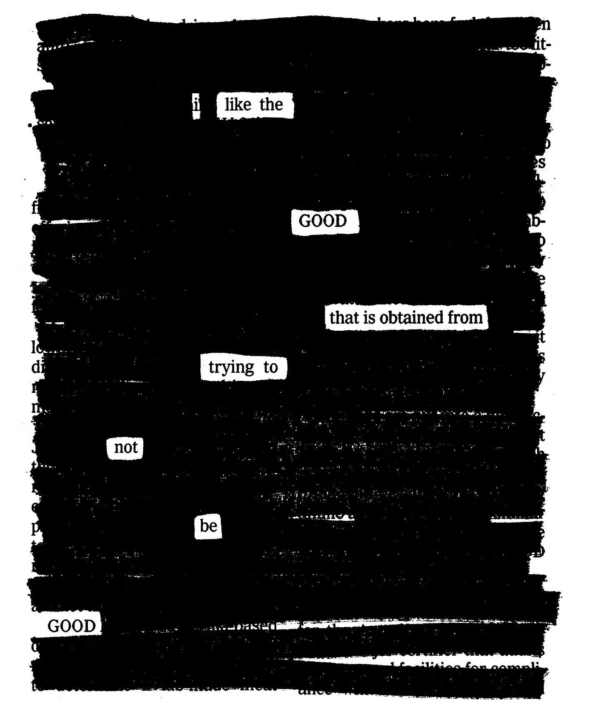
An old blackout poem pulled out of a notebook…

An old blackout poem pulled out of a notebook…
Last January, after seeing a couple of my newspaper blackout poems, Winston Smith e-mailed and recommended to me a book called “A Humument” by an artist named Tom Phillips. In the mid-sixties, Phillips took an old Victorian novel by W.H. Mallock called “A Human Document” and started blacking out the pages to make a new book, ” A Humument.” Well, I thought this sounded pretty interesting, but was too lazy to look it up, or even Google it, and pretty soon I’d forgotten all about it.
A year later, Drew Dernavich e-mails me a link to Humument.com, the official site of the book! Little did I know that you can see every page from the book online. (There’s also a new edition you can buy online from Amazon.)
Too cool.

I found this blackout poem while I was going through some things to compile my portfolio. People ask me if I’m getting nervous about the big day. I feel like this poem says it all.

Photo credit: Clayton Cubitt
Here’s a longer, more official-sounding version, suitable for copying and pasting:
Austin Kleon is the New York Times bestselling author of a trilogy of illustrated books about creativity in the digital age: Steal Like An Artist, Show Your Work!, and Keep Going. He’s also the author of Newspaper Blackout, a collection of poems made by redacting the newspaper with a permanent marker. His books have sold nearly two million copies and have been translated into over 30 languages. He’s been featured on NPR’s Morning Edition, PBS Newshour, and in The New York Times and The Wall Street Journal. New York Magazine called his work “brilliant,” The Atlantic called him “positively one of the most interesting people on the Internet,” and The New Yorker said his poems “resurrect the newspaper when everybody else is declaring it dead.” He speaks for organizations such as Pixar, Google, Netflix, SXSW, TEDx, Dropbox, Adobe, and The Economist. In previous lives, he worked as a librarian, a web designer, and an advertising copywriter. He lives in Austin, Texas, with his wife and sons. Visit him online at www.austinkleon.com
The best way to stay in touch is to subscribe to my newsletter.
To get in touch, contact me.
B. June 16, 1983, Circleville, Ohio
Education: B Phil. in Interdisciplinary Studies, Miami University
Pronunciation: Austin, like the city. Kleon, rhymes with neon.
Origin of name: “Austin” was a family name before Texas was a state. “Kleon” is Romanian.
What advice do you have for young artists starting out? It’s pretty much all in Steal Like An Artist.
How do I get published, famous, etc.? My book Show Your Work! is a guide to getting your work out there, and my book Keep Going is how to stick with it for the long run.
How did you come up with the idea to make your newspaper blackout poems? There’s a brief history on the blog and the full story is in the book.
What are your favorite books? Here are my favorites from the past +15 years.
What kind of notebooks do you use? Here’s a bunch of gear I use in the studio.
This interview with photographer Chase Jarvis is a great introduction to my work, as is our most recent conversation.
You can watch more of my talks on my speaking page.
More recent interviews on the blog.
I’m doing some of my best writing, I think, in my Tuesday newsletter.
This week, I wrote about “entering into the spirit” of the holidays:
For artists, we get to play at Halloween all year. That veil between the material and the immaterial stays razor thin. Every day, we get to step into our costumes, don our masks, perform our rituals, and enter into the spirit.
Two weeks ago, I shared three poems from the sports section:
For years, my favorite section of the New York Times for making newspaper blackouts has been the Sports section. (Ironic, considering they recently disbanded their sports department.) This isn’t because I’m a huge fan of sports, but because you find good nouns and verbs there: I like the way coaches and athletes talk in plain language — and sometimes clichés! — and how they speak a lot about “seasons,” etc.
I stitched those poems them together with quotes from my commonplace diary and the result was really fun. I’m going to try to do more letters like this soon.

Three weeks ago, I wrote about the art of forgery:
Because I wrote a book called Steal Like an Artist, some people think I’m really interested in plagiarism. Actually, I’m much more interested in forgery.
“Plagiarism is the flip side of forgery,” wrote Andrew Potter in The Authenticity Hoax. “Forgers pass off their own work as that of someone else, while plagiarists pass off the work of others as their own.”
In other words: Plagiarism is taking credit for someone else’s work. Forgery is giving someone else credit for work you create.
The difference is you doing the work.
Though I love having the deadline and the form to play with, what’s best about the Tuesday newsletter is the comment section — a sane corner of the internet that makes me feel better about the world. (See our recent “What’s Good?” discussion thread for a lift — there’s a free trial at the paywall.)
This site participates in the Amazon Affiliates program, the proceeds of which keep it free for anyone to read.